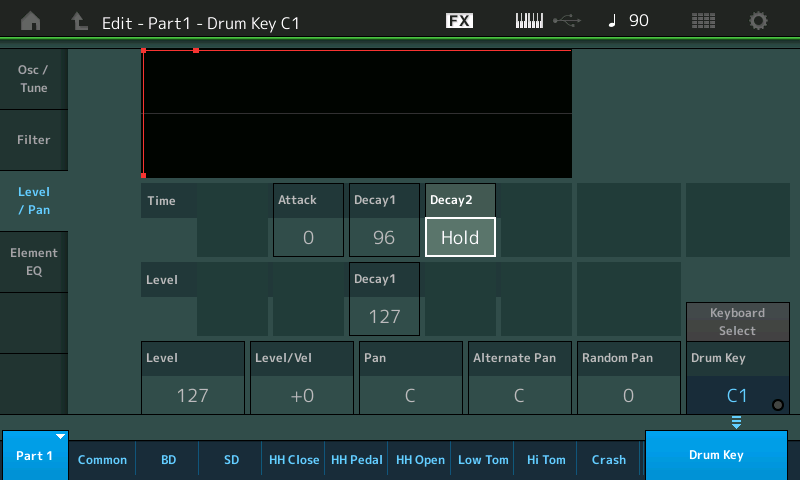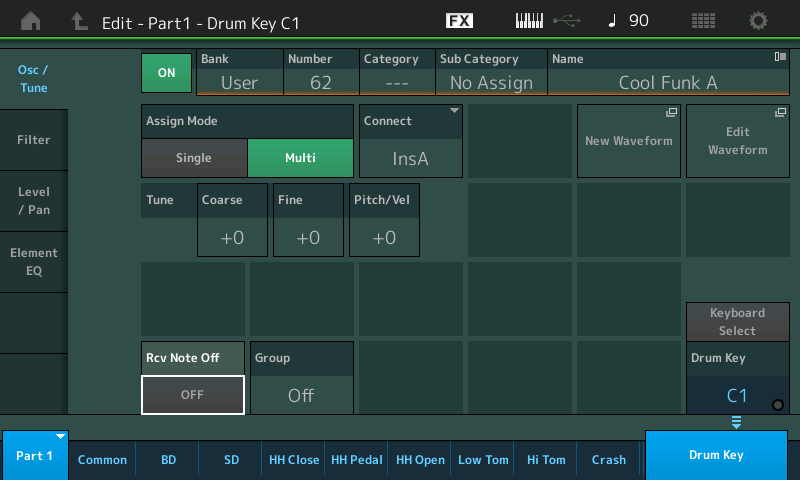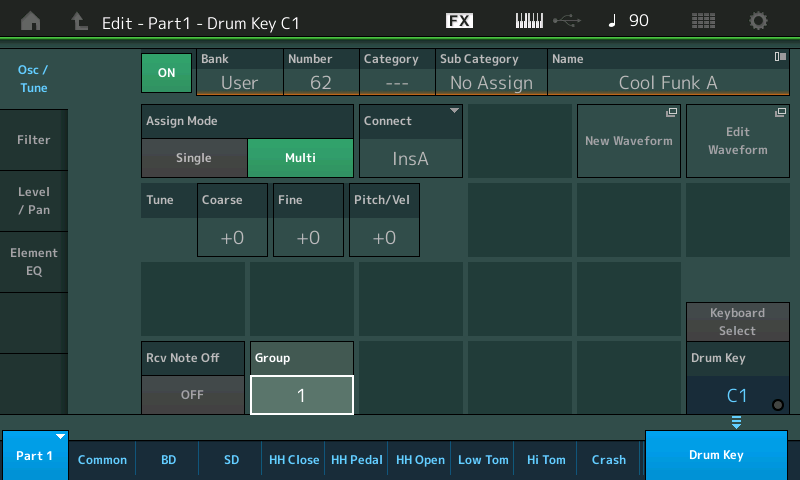Hello. I have been tormented for 2 days and cannot find the hold button, so that after releasing the key it continues to sound further.
there is no hold button. The solution to a latch function would be to use a DAW or increase the sustain or use an arpeggio with the HOLD function on.
FM-X can have infinite hold after release. Sampled sounds eventually will decay. This can be set in FM-X's amplitude envelope and you can tie a controller (like A.SW1 or A.SW2) to shorten the release time in order to decay the note. I believe this is retroactive for notes already holding - although I have not worked with this aspect recently.
EDIT: Yes, if I use "FM Wr" as a basis, then I can set A.SW1 (Mod/Contron -> Control Assign) to OP8, turn on the switch, change the OP8 rate to +7, set a standard curve with ratio of +64, destination as OP AEG OFFSET. This will give infinite sustain after release when the key is released while A.SW1 is on and will immediately cut off when the switch is turned off. OP AEG OFFSET is not the same as just affecting the release level - but is closest one can get since individual segments cannot be offset - only the entire curve.
AEG Release can also be used - but it will eventually decay.
Hello. I have been tormented for 2 days and cannot find the hold button, so that after releasing the key it continues to sound further.
If you need to create an envelope with infinite HOLD, it is recommended that you use a Drum Kit (AWM2) Part to house the sample. One of the differences between the Normal AWM2 Part and the Drum AWM2 Part, is the AEG behavior. (Amplitude Envelope Generator defines the loudness/Level of the Audio over time... it is the ADSR attack-decay-sustain-release settings).
Normal instrument sounds typically require you engage and hold the key down for duration of the time you wish it to sound, then when you release the key (or the Sustain pedal) the envelope proceeds to the Release Time setting. If the Key is Released before the audio sample has completed its programmed AEG tour, it proceeds directly to the Release Time setting.
The behavior of percussive envelopes will always have Decay2 Time = 0 (a piano envelope for example, will eventually die out due to gravity and air friction working against the movement of the string). Piano being the one percussion instrument that can delay the inevitable return to silence... Normal AWM2 AEGs are designed to mimic instrument behaviors.
Drum AWM2 envelopes can be set to ignore Note-Off so it is possible to have a Drum Part’s Envelope to play the complete audio clip without the need to hold down the key. (Hit a cymbal, you expect it to sound without having to hold the Key down). The Drum AWM2 AEG can be set so “Decay2 Time” can be 0-126, HOLD. HOLD will set the sample to play indefinitely, without having to engage the Key continuously.

If you are creating a situation where you want the audio clip to play continuously, place it on a Drum Kit Key, C0~C6. Set the Key to “Receive Note-Off” = Off. Set the AEG "Decay2 Time" = HOLD (maximum). The sample assigned to this Key will sound continuously.

You may additionally want to set the Key "AssignMode" = Single so that only one instance of the Audio can play...
Extra Credit: The Drum Kit Part is often used to house not just Drum and Percussion Instrument sounds, but audio clips and loops that need to play endlessly. You can assign any Key in a Kit to an alternate "Group”. The "Groups", 1-127, allow just one assigned Key to sound per Group. For example, the Hihat Closed, Hihat Pedal, and the Hihat Open are typically assigned to the same alternate Group. This way only one of them can sound at a time.

The Closed Hihat will stop the Open Hihat from sounding as soon as it is played. The Open Triangle and Mute Triangle share the same alternate Group so that one can be used to stop the other from ringing... Only one Key from any Group can sound at a time. This can be used effectively for audio clips that Loop. You can have one Looped clip replace another by placing them in the same Alternate Group. Additionally you can create a “Stop Key” by assigning a ‘silent’ Key (Element Level = 0) so that it can be used to end any audio clip set to Hold.
Additional Reading:
Learning about (AWM2) Envelopes...
